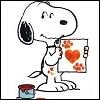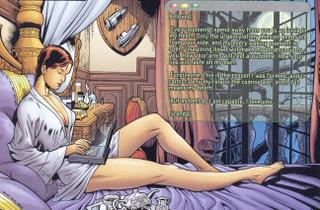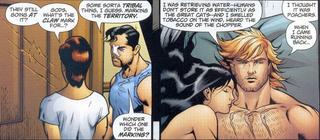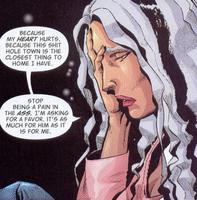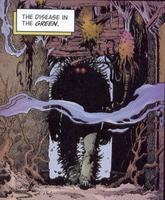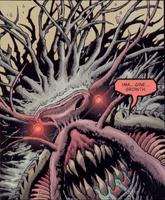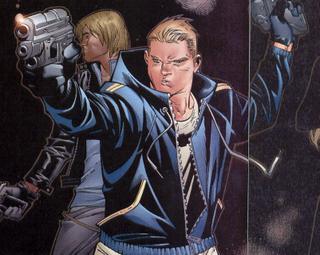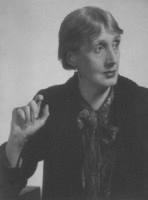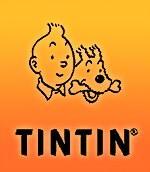A little while ago, Shane Bailey asked me a question that I’ve been thinking about a great deal since I began this blog:
I was wondering, as I do when I read most critical readings of different books, how you can tell if the artist or writer actually meant to instill those ideas or feelings within the reader or if they were some kind of happy accident. A subconscious thought that works its way into whatever their current project is. I don’t think that’s a question that can be answered, but I still wonder...Me too. And I think Shane’s right: this is an “unanswerable” question. Nonetheless, drunk with hubris, I started to improvise an answer to it in response to his original comment. A thousand words later, I realized that my response was becoming an essay, and not a very good one at that. I’d spun my wheels a great deal, but still wasn’t approaching anything remotely resembling a satisfactory answer. Most importantly, the answer I’d begun didn’t strike me as tedious or long-winded enough. I thought I’d been doing a pretty good job of hiding my glee, but Chris Tamarri wasn’t fooled. As he aptly pointed out in a really nice post about this blog on Crisis/Boring Change (thanks Chris!) I do like to punish lazy readers with cruelly labyrinthine posts. Sometimes I find myself wondering if less maybe really is more, but then I think: Why settle for a pithy but convoluted 1000 words when you could easily come up with three or four times the material, alienate what few readers you have, and increase the level of punishment exponentially?
So I did what any sadistic yet conscientious blogger would do under the circumstances. I stalled for time. I procrastinated. I fed the fish. I blogged about other things. I watched TV. I even did the dishes and took out the garbage. Finally, after much avoidance, I plotted. I came back to it. I though about it. I thought about how I’m approaching the interpretation of comic books, and how I could turn a simple reply into a pedantic assault. I also thought about how my own approach to superhero comics might relate to the more general question about the artistic value of superhero books as compared to, say, the more self-consciously “literary” efforts of indie gods like Seth or Daniel Clowes. With sincere apologies to Shane for hijacking his question so thoroughly, this is what I’ve come up with...for now. (No thanks, Jim, I’m outta here.) Seriously, though, if anyone else has thoughts about these knotty issues of interpretation, meaning, and value that we all no doubt wrestle with, I’d love to hear them. (Seriously, Roeg, I’m gone.)
Literature and Intention: Author- vs. Reader-Centered Theories of Meaning
how you can tell if the artist or writer actually meant to instill those ideas or feelings within the reader or if they were some kind of happy accident?Obviously, for anyone who interprets art, this is the question. The Big One. It’s a question that contains many even more fundamental questions about the nature of art in general, the nature of specific subgenres (including comics), and the nature of the relationship between the author, the text, and the reader. In other words, like any question about interpretation, it raises vital questions about where meaning comes from and how art “works.” (A subject on which there is obviously no shortage of opinion!)
What this question asks directly is something like: how can you tell if your interpretation (“those ideas or feelings”) is “right” and not just a whimsical reading that you are projecting onto the work (a “happy accident”)? When it’s phrased this way, the assumption is that the text is an artifact that the author has “instilled” with a certain intended meaning and that our job as readers is to somehow retrieve this originally intended significance. This theory of art presumes that the artist knows what the text “really” means (since they wrote it!), and that the reader is always in danger of getting it wrong. Art is a special form of communication, capable of conveying “more” than average speech, but the very thing that allows it to be the carrier of surplus meaning and affect is also what fills all of its messages with ambiguity so that the “intended” meaning is easily misconstrued. That’s one theory.
But this question also implies a second, related question about whether or not this is the only way to conceptualize the relationship between the author, the text, and the reader when thinking about where meaning comes from. The theory that writers have clear, specifiable intentions and “instill” ideas and feelings in a work of art is an author-centered theory of meaning, but it is by no means the only way to go. There are also various text-centered theories of meaning, not to mention an array of reader-centered ones too. In the case of reader-centered theories, meaning is (to varying degrees) seen as emerging not (or not primarily) from the author’s intention (which is inaccessible to us anyway, since we can’t read minds) but from the reader’s interaction and “play” with the text itself. In other words, all meaning is, to a large extent, a “happy accident,” the result of “a subconscious thought” that is produced in the act of reading.
Whereas the author-centered theory envisions art as expressive (a communicative act) and imagines the text as a sort of container that the artist puts meanings into for us to retrieve, the reader-centered theory envisions art as a structure that makes possible certain forms of readerly creativity: a multidimensional web or network of words and images whose allusiveness and density make a single meaning difficult if not impossible to pin down, in which case art is not really communicative in the usual sense at all, and there is no “right” meaning, regardless of what the author might have “intended” when they built the structure. Or, to put it more accurately: even if the author did intend one specific meaning, too bad for him or her! We have no way of getting to it, so we might as well have fun exploring and examining its possibilities in a way that is, inevitably, as creative as it is “interpretive.”
This is a very crude caricature of the author-centered and reader-centered poles of the wrangle over meaning that has animated more than a century’s worth of academic scuffles. (Both poles overlap with the text-centered approaches, which I’ve glossed over in this summary just to prove that I’m not totally sadistic.) Much critical blood (and ink) has been spilled on both sides of the fence, and Wikipedia has some good general overviews of the relevant literary debates on authorial intention, the intentional fallacy, and the death of the author.
My own very rough take on these literary questions is that although the “intention” of a writer is probably never singular, simple, or even paraphrasable, and even though what a piece of literature “means” is neither determined nor limited by what the author may have had in mind when it was written (because there’s no “meaning” without the reader), and even though the fact that a writer (like any of us) may not be totally cognizant or in control of what is motivating the creation of their work (i.e. “a subconscious thought”), and—yes!—even though the medium of expression itself is treacherous and impossible to pin down (words have multiple connotations, ambiguities, double-meanings, etc.)—despite ALL of these things (which I largely grant), I STILL think it is both possible and necessary to think about literature (and indeed all art) in terms of some sort of “authorial intention”—even if it is only a “weak” and vastly qualified theory of intentionality.
We might end up concluding that a particular author isn’t completely in control of everything he or she is “intending” to do, or that “intention” runs up against some external constraint such as a genre convention (or an editorial dictate that the story must have a happy ending, say). But without some concept of intention, my feeling is that we lose track of the fact that art is above everything else a willed human activity and that even the seemingly “simplest” narratives are often riven with subtlety and complexity by virtue of that shaping will. We lose track, in short, of the fact that art is more often than not a communicative act—just a very, very complicated one, not limited to notions of “expression” or “inspiration,” whose messages happen to exceed the apparent “limits” of their containers (since words have many possible meanings). This exceeding of the limits of communication is precisely what makes art, well...art, but it is not (in my view) ultimately separable from the human will of the artist who has, after all, imposed some form on the real chaos of the potentially infinite materials of expression (words and images) through careful selection and combination. To be good interpreters of art, I think, we have to hold both the will of the artist and the chaos of the medium together in our heads all at once.
Double Articulation, part 1: Reading Between Ethics and Pleasure
If I were to try roughly to characterize my own philosophy of the relation between authorial intention and interpretation, I think it would go something like this:
1. All art is “intentional” (even if the “intention” is to be as spontaneous as possible so as to appear to have no intentions, as in certain forms of avant-garde literature or visual art).
2. If we are going to retain the concept of “intentionality,” we have to understand it in a way that is complex enough to admit the possibility of multiple (sometimes conflicting) intentions.
3. We also have to acknowledge that the meaning of art is not limited by these intentions for a variety of reasons: external constraints like genre, the specific social and historical circumstances in which something is read, and the author’s own unconscious, which makes it foundationally impossible for him, her, or anyone to fully know their own “intentions”—to name a few.
4. We also have to grant that the medium of communication is not reliable—words and images are unstable communicators of meaning because one word or image can have multiple meanings, and when they’re placed in combination, the potential meaning increases exponentially until it becomes impossible to name exhaustively.
5. “Meaning” only emerges when someone (a reader) actually encounters the art. And since all readers are different each one will interpret things differently, at least to some degree. (If a tree falls in the forest and there’s no one around to hear it, it doesn’t make a sound, according to this view.) Clearly, whatever the author “intended,” no matter how complex a notion of “intentionality” we posit, is going to be very difficult, if not impossible, to reconstruct.
6. As a reader, I’m not necessarily aiming to reconstruct some original “intention,” so much as trying to construct a plausible interpretation of the work in front of me that is related to but not limited by authorial intentionality. That is, I’m trying to remain conscious of the existence of an original matrix of authorial “intentions,” and for me, this supposition acts as a sort of horizon against which I’m constantly measuring and checking my own reading and that I’m always trying to stay mindful of, even if I know that it is permanently lost and is probably too complex to fully reconstruct even if it were possible to do so.
7. At the end of the day (and this is just me), I try to approach reading as an ethical activity—that is, I think of reading as one of the most basic ways in which we interact with another person at a very deep level on a daily basis. And I guess I feel (on one level at least) that we owe it to the artist to try to understand their work as a communication. The fact that the full, exact nature of this communication must always remain inaccessible leaves us with an interesting philosophical dilemma, one that is ethical in the truest sense: is it still worth trying to understand someone even if we enter into this relationship with the knowledge that we never entirely will? My answer, obviously, is “yes,” because this is true of every relationship we enter into, even if it often feels that our knowledge of the person before us is perfectly transparent.
This “ethical” dimension of reading is complicated, however, by the fact that, on another level, reading is undeniably about our own pleasure, and the pleasure of our own interpretations and projections—things that we can enjoy more fully in reading than in real life because there are no consequences to projecting our own desires into the purely imaginary space that reading conjures up. Besides, like those cheesily decadent European dignitaries in the Ferrero Rocher chocolate commercials, I would never, never deny my friends pleasure (much less deny myself), so for me, being an “ethical” reader involves a balancing act that I attempt to justify through disclosure: I try to keep my approximation of what I think an author most likely intended front and center in my interpretation, while at the same time trying to be clear about the moments when I’m breaking off and beginning to read more creatively for my own pleasure—those moments when my reading of a text shifts from being author-centered to reader-centered, when I begin to read perversely and autobiographically. Hence (in part), the title of this site, Double Articulation, and also the subtitle, A Comic Book Life.
Does this answer Shane’s unanswerable question? Not even close. The decision that something was “intended” by the author as opposed to being merely “projected” by the reader remains a judgment call. And there are all kinds of things that any critic brings to bear when making such a call. Their reading skills, obviously. Their knowledge of formal and generic conventions. What they know about the history of the medium. What they know about the author’s other work. Perhaps (though this is no longer fashionable) what they know about the author’s life. What they know about psychology, history, politics, etc. What they know about the specific time and place the author was writing. And what they know about the material aspects of the production, circulation, and consumption of the final product. These are the basic tools, and they are all perfectly fallible. But if we believe that some interpretations are better than others, that some interpretations tell us more about the text than others, if we wish to be ethical readers, then it is necessary to retain some abstract sense of an “authorial intention” even if it is only in the form of a distant, ever-receding horizon. Without it, we lose the philosophical grounds to make the judgment call that Shane’s question implicitly (and in my view, very rightly) demands.
Comic Books, Superheroes, and Questions of Value
The debates over art, meaning, intention, and interpretation are complicated enough in literary circles where we are dealing usually with only a single author. But they become even more complicated and interesting when dealing with a multi-authored form like comic books where “intention” is already diffused between the writer and the artist, not to mention the inker, colorist, letterer, and editor. Sure, sometimes a writer and artist work so closely together that they achieve what I’ve often called “synergy”—a working relationship so intense that they seem to share a single intention (Wolfman and Perez’s New Teen Titans is my pet example, as most of you know; it would be easy to name others). But this idea of synergistic creativity is really just an illusion of singular intention and is probably much closer to complementarity than perfect accord. The reality of synergistic partnerships probably involves a very complicated form of give and take whose dynamics are difficult to reconstruct, even in rough approximation. (I like to imagine that Fantastic Four #176 is a paradigm of this dizzying synergistic process.) It’s easier to retain a belief in the more traditional notion of authorial intention when reading the work of do-it-all comic auteurs like Frank Miller, David Mack, Daniel Clowes, John Byrne, or Gilbert Hernandez, but even for these writer/artists, all the complications of intentionality raised by the literary debates over the term still apply. Perhaps there’s a sliding scale on which these two types of comic book intentionality fit. That is, it might be possible to argue that “authorial intention” (the weak version I’ve argued for above) is a category of analysis that has more obvious relevance to interpreting an auteur book like Eightball than to interpreting an old Wein/Perez issue of the Fantastic Four insofar as the concept of “intention” implies a high degree of shaping artistic will and formal control. Maybe, though even here, I'm not totally convinced of the value of this distinction between “high” and “low” comic art that this example implies. For now, my point is merely the simple one that some concept of authorial intention continues to matter in both cases, even though it becomes an increasingly complex issue as the number of artists involved increases.
The literary debates over intention and meaning are also complicated by the fact that storytelling in mainstream comics is not only heavily market-driven but genre-based—two factors which seem, for many readers and critics, to exempt superhero comics from being considered to have either “literary” ambitions or merit. This assumption pervades what might not unfairly be called the Indie snob position, which replicates the position that literary snobs assume in relation to pop culture and genre fiction generally. The assumption of all readers who slam genre fiction (be it romance novels, horror novels, SF, fantasy, manga, superhero comics, what have you) is that only certain types of narrative are worthy to be designated as “art” on the grounds that they are truly “free” artistic expressions: that is, that they are not constrained or limited by external factors like genre conventions or editorial demands. To put it very crudely: something like House of M can’t be art because it is a “market-driven” narrative (not truly creative), because it caters to very specific forms of fantasy gratification (it is escapist and trivial), and because it is too plot-oriented (it minimizes the wonderful ambiguities that characterize “real” art). Something like Eightball (which I love, incidentally!) is seen as genuine art because it is “independent” of all these constraints. One also suspects—though I could be wrong—that it is valued as “art” because it is produced by some people’s vision of the archetypal artist: a lone artistic genius who exists—ostensibly—outside the realm of vulgar, mainstream, “mass” production. If this is true, then comic book criticism turns out to be the last bastion of modernist aesthetic values, or at least, of romanticism.
The foregoing comparison is somewhat facetious because, personally, I have no problem conceding that Eightball is better (more interesting, more sophisticated) art than House of M (nor, I expect, would most readers). What I’m unwilling to concede, however, is the presumption that the work of an independent writer/artist is by its very nature superior to or more complex or sophisticated or interesting than mainstream genre work produced by multiple writers and artists—that these genres are foundationally incapable of producing narratives that command our attention in the ways that we have been trained to associate with the evaluative term “art.” (On a related point, Mark Fossen has just posted a sharp analysis of the current Indie/mainstream fracas that questions all of its foundational categories in a measured, productive way. It is essential reading for anyone following this debate.) As anyone who has been paying attention well knows, genre writing—especially horror and science fiction—have as much, if not more, to tell us about the monstrous world of contemporary history than much of what passes for current “literature” (which is often far more reactionary and “escapist” than the genre works it supposedly surpasses). That superhero comics can also illuminate our world and our lives in the manner we expect from all great art is old news to comic fans after Watchmen, even though culture at large is still catching up.
What this little digression has to do with my qualified defense of authorial intention is simply this: retaining a notion of authorial intention is one way (not the only one) of taking mainstream superhero comics seriously, of treating them as potentially illuminating “art,” even when they sometimes appear merely to be “product.” One might be tempted to say that the “authorial intention” behind Marvel and DC’s current line-wide events is all too evident, all too cynical, and all too little like “art” to be worth our time or money. One might notice, in other words, that “authorial intention” in comics these days is simply an extension of “editorial intention.” But then I read a book like Villains United or JSA and I see so much more going on at an “artistic” level than initially meets the eye (in terms of form, themes, and symbolism) that I find much more than simply my own uncritical nostalgia and love of continuity to interest me. Although I flagged Watchmen above as an instance of the potential of superhero comics, I’ve deliberately avoided mentioning the mainstream work of Grant Morrison here precisely because Morrison is usually treated as the notable exception to the “rule” of mainstream banality and his work is already accorded a sufficient degree of artistic weight and merit that it has been interpreted with the same level of attention and close reading that one would accord a “literary” text. The same attitude has not, by and large, been extended to most mainstream superhero books or their (multiple) authors. My position is that it should be.
Double Articulation, part 2: From Narcissism to Criticism
This site began as an exercise in what I like to think of as harmless, mild-mannered narcissism. Like most bloggers, I wanted to talk about myself and to reflect on my life through the medium of my chief obsessions. In particular, I wanted to think about how the ephemera of childhood turn out to be the building blocks of self, how a stack of ratty old comics turns out to contain the materials out of which my adult personality was and continues in many ways to be fashioned and understood. That anyone other than me could be diverted by my self-interested musings was a pleasant surprise—as pleasant as my (belated) discovery that I wasn’t the first geek to have this thought. (But really, it’s probably best not to encourage me.)
I began this blog, in other words, with a heavily reader-centered approach to interpreting the comics of my youth. However, what I found when I went back to those early comics that captivated me—particularly the Fantastic Four of the late 1970s—was that their narratives were far more sophisticated than I had ever realized, and that they supported much weightier interpretations than I had initially expected they might. Sometimes, the sophistication of these narratives is largely implicit, apparent only as a sort of subtext, but that does not necessarily mean that it is merely “unconscious” on the part of the writer. The multilayered meaning (and very adult double entendres) of a comic like Fantastic Four #186 is perhaps best accounted for by the fact that mainstream superhero books were marketed to children but featured adult characters and situations, and were written by (and to some extent for) adults. This doubleness at the core of many (even most) superhero titles both then and now demands that we interpret both carefully and generously—that is, that we give writers of superhero comics the benefit of the doubt and err always on the side of attributing too much sophistication to their work rather than not enough, which is more usually the case. I suspect that we'll be right more often than we'll be wrong.
The fact that I was surprised to discover such sophisticated narratives in my childhood superhero books was a good reminder of how prevalent the prejudice against the superhero genre is, even among its most unremitting enthusiasts. Like science fiction, fantasy, and horror fiction, superhero comics began as cultural ephemera and are (very) slowly gaining “legitimacy” as an art form whose sophistication, power, and relevance is gradually being recognized by a wider public and within academic institutions. My own take on the vitriolic divisions within the comic blogosphere (and it is hardly an original one) is that they reflect different strategies for legitimizing comics—strategies which are founded on different assumptions about what artistic achievement looks like and about the relevance and resonance of the superhero genre to contemporary experience. And like all culture-war debates, it will cool down, flare up again, blow over, and do its work despite itself. If we want a crystal ball to see where all this is headed, the best place to look, in my view, is to the history of popular genres like science fiction and fantasy in the twentieth-century. Like these genres, superhero comics are an integral part of contemporary culture, and they are being written and illustrated by incredibly talented, sometimes brilliant people. Not only are they here to stay, they have a history that is already so vast, fascinating, and barely examined that it’s hard to know whether to look forward or back because there are incredible sights in both directions.
I don’t know about you, but I’ve had enough blogging for one day. It’s time to sharpen my pencil, sit back, open a comic, and head for the horizon.
